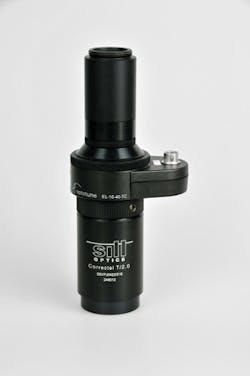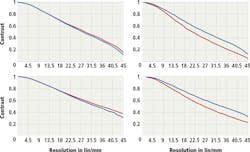Telecentric lenses with variable working distance
Focus-tunable lens enlarges useable depth of focus
by Mark Ventura
Sorting, mobile device inspection, and display and PCB measurement applications require optics with long depth of field and variable working distances. Telecentric lenses with an integrated focus-tunable lens enable reproducible measurement over a large focus distance within milliseconds.
With object-sided telecentric lenses the entire depth of field can be used for an accurate X-Y measurement of objects that have different heights within the field of view. The magnification is constant throughout the entire depth of field. The depth of field depends on magnification, aperture and required resolution. High magnification lenses have a severely restricted usable depth of field, since a very large aperture is needed for sufficient image performance.
Besides the fast and flexible focusing of objects at different distances, the big advantage of integrated focus-tunable lenses in telecentric lenses is a comparatively larger depth of field. The large depth of field is achieved by a tunable lens, which can be controlled electronically. The tunable focus lens, part number EL-16-40-TC from Optotune, offers an adjustment range of the refractive power from -3 to +3.5 diopters. This full range can be achieved with a single move, that takes only 20 ms or with a steady ramp of 100 ms. If a stack of pictures is taken, a "hyperfocus" or "extended depth of field (EDoF)" picture can be created with suitable software. It can also be used to measure object distances, a technique called depth from focus (DFF).
Integration of the liquid lens
The optical design is crucial when integrating a liquid lens into a telecentric imaging lens. The telecentricity principle defines that the aperture stop has to be projected to infinity on the telecentric side. Accordingly, the focus-tunable lens has to be placed behind the aperture for object sided telecentric lenses. For this reason, a bi-telecentric lens with a focus-tunable lens is not possible.
The following design requirements can be set for telecentric lenses:
• Large focus range
• Low, linear change of magnification over this range
• Constant image performance
• Low change of distortion
Constant telecentric error
To enable this system for a wide range of users, the first step was to integrate the liquid lens in an existing lens design. As a specialist for small-batch production and custom specific solutions, Sill Optics also offers individual optical designs with focus-tunable lenses.
Nominal design, performance and measured results are shown for a 2x magnifying telecentric lens (Figure 1) and a 1" sensor.
Performance according to simulation
Design parameters are shown below with regard to the zero position of the focus-tunable lens:
• Magnification: 2.0x +/- 1 %
• Working distance: 106.2 mm +/- 2 %
• Object size: 4.8 mm x 6.4 mm for sensor size 9.6 mm x 12.8 mm (1" sensor)
• Wavelength range: 450 - 700 nm
• Object sided numerical aperture (NA): 0.04 at middle size aperture
• Theoretical max. distortion 0.61 %
• Theoretical max. telecentric error 0.01°
In standard configuration (fixed focusing), the lens has a depth of field of 0.3 mm for a pixel size of 7 μm and NA of 0.04.
The change of refractive power [D = 1/f'] of the tunable lens EL-16-40-TC from -3.0 to +3.5 diopters [dpt. = 1/m] increases the useable depth of working distance from 111.5 mm to 99.4 mm. This results in a maximum Z-range of about 12 mm which is a 40 times higher depth of field.
Because of the affected focal length, the magnification changes over the focus range. Change of magnification is +/- 3 % compared to the nominal value and shows a linear dependence from the refractive power (Figure 2). This influence can be eliminated by calibrating the measurement system.
Imaging performance is nearly constant over the whole focus area. Changing focal length or changing working distance at constant NA varies the diffraction limit slightly. For a shorter working distance (+3.0 dpt), the diffraction limit is slightly higher. MTF plots are calculated with NA = 0.04 and show an almost homogenous image quality (Figure 3).
Distortion of the telecentric lens stays the same type (positive, pincushion distortion) and varies linearly from 0.73 % (-3 dpt) to 0.47 % (+3.5 dpt) through the whole focus range. The measurement influence can also be eliminated by calibration measurements at different distances.
By definition, telecentric error remains constant, because it doesn't depend on the system's working distance or focal length and the front part of the lens stays the same.
Measurements confirm the simulation
The measurement of the first lens series shows an approximately nominal performance. At the zero position, the measured focus-tunable lens shows the following properties:
• Magnification: 1.983x
• Working distance: 105.70 mm
• Max. distortion: 0.97%
• Max. telecentric error: 0.05°
The measurements show a Z-range of approximately 13 mm (+6 mm / -7.2 mm). Linearity of working distance and magnification can also be confirmed in practice (Figure 4). Additionally, the magnification shows a low deviation (+2.6 % / -3.2 %).
Distortion over the whole focus area is below 1 % and telecentric error below 0.1.
The imaging quality is determined with the MTF-Master on a monochrome sensor and with white illumination. As usual in practice, the best aperture is chosen by manual adjustment. Thus, it's possible that the maximum values are higher than the theoretical values for NA 0.04. The MTF results confirm a good imaging performance even in the field edges (Figure 5).
In this case, the influence of the shorter focal length becomes apparent. For shorter focal length, a slightly higher resolution with constant aperture is achieved.
In conclusion, the lens achieves good imaging properties over a Z-range of approximately 13 mm. Magnification and working distance show an almost linear dependence on refractive power. With calibration measurements, a reliable and highly precise result can be achieved.
The design data describes the system parameters reliably, so that future developments can be planned. Thus, wide application fields open up for telecentric measurement systems.
Mark Ventura, Optotune AG, Dietikon, Switzerland (www.optotune.com), and Andreas Platz, Sill Optics GmbH, Wendelstein, Germany (www.silloptics.com)





